 This is an Argus C44R, a 35mm rangefinder camera made by Argus Inc., between the years of 1958 and 1962. It was an update to the earlier C44, adding a rapid wind lever, a pop up rewind lever, and plus a provision for the optional Argus CM2 coupled exposure meter. The C44R is one of the most advanced and modern cameras Argus ever made, featuring a combined image coupled rangefinder, a six speed shutter, an interchangeable bayonet lens mount, an optional coupled light meter, and a modern design. The C44R offered a competitive feature set at an affordable price within the reach of the average American photographer who wanted the flexibility of an interchangeable lens rangefinder, but without the expense of German or Japanese options.
This is an Argus C44R, a 35mm rangefinder camera made by Argus Inc., between the years of 1958 and 1962. It was an update to the earlier C44, adding a rapid wind lever, a pop up rewind lever, and plus a provision for the optional Argus CM2 coupled exposure meter. The C44R is one of the most advanced and modern cameras Argus ever made, featuring a combined image coupled rangefinder, a six speed shutter, an interchangeable bayonet lens mount, an optional coupled light meter, and a modern design. The C44R offered a competitive feature set at an affordable price within the reach of the average American photographer who wanted the flexibility of an interchangeable lens rangefinder, but without the expense of German or Japanese options.
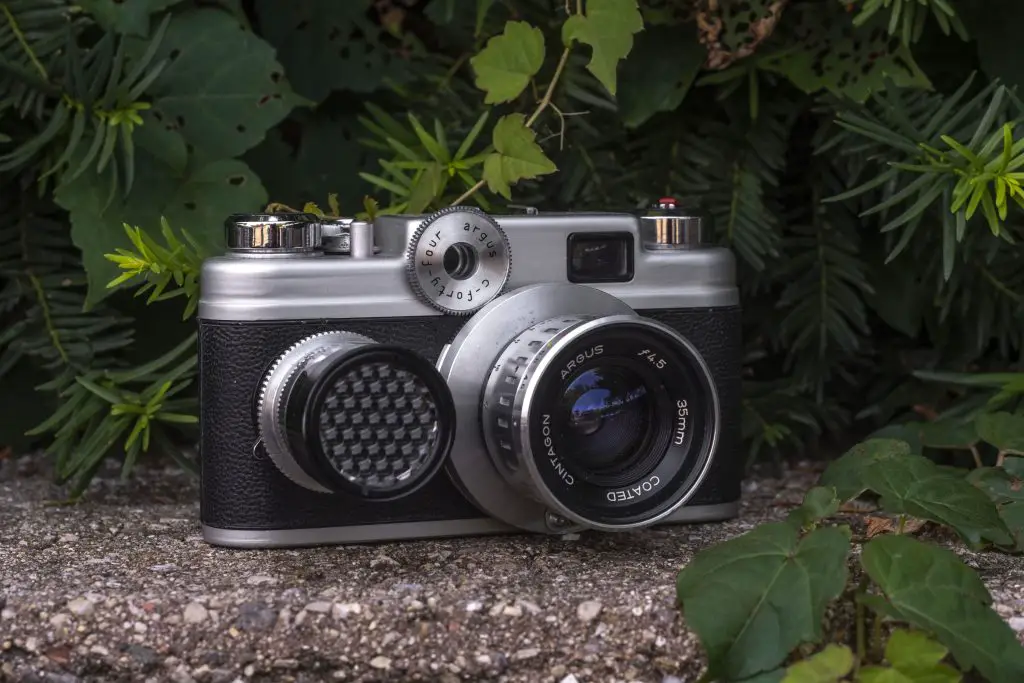 Film Type: 135 (35mm)
Film Type: 135 (35mm)
Lens: 35mm f/4.5 Argus Cintagon coated 4-elements
Lens Mount: Argus C44 Bayonet
Viewfinder: Coincident Image Coupled Rangefinder
Shutter: Argus Leaf
Speeds: B, 1/8 – 1/300 seconds
Exposure Meter: Optional Argus CM2 Coupled Selenium Cell
Battery: None
Flash Mount: Hot shoe and M and X Flash Sync
Weight: 805 grams (w/ meter and lens), 718 g (w/ lens only), 588 g (body only)
Manual (C44): http://www.cameramanuals.org/argus/argus_c-44.pdf
Manual (C44R Addendum): http://www.cameramanuals.org/argus/argus_c44-r.pdf
How these ratings work |
The Argus C44R was the pinnacle of camera design for Argus. It had nearly every feature that a modern 35mm camera should have at the time of it’s release in 1958. With interchangeable lenses, a clip on coupled exposure meter, coincident image coupled rangefinder and modern ergonomics, it was one of the most advanced American made cameras of it’s day. In use however, I found the camera to be clunky and stiff. I also got strangely soft images from the Steinheil made wide angle lens. I feel as though this is a camera I should have liked more, but didn’t. | ||||||
| Images | Handling | Features | Viewfinder | Feel & Beauty | History | Age | |
| 1 | 1 | 1 | 2 | 0 | 1 | 30% | |
| Bonus | none | ||||||
| Final Score | 7.8 | ||||||
History
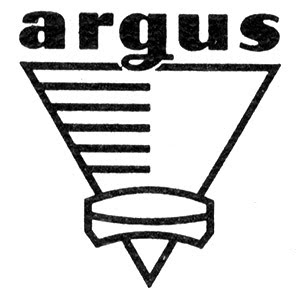 In 1938, when Argus released the first C-series camera, they were still a relatively unknown company in the photographic world. Sure, their current Argus A-series was selling well, but it was an inexpensive low end camera that didn’t compete beyond the $10 – $15 price point for a camera and they were unheard of outside of the United States.
In 1938, when Argus released the first C-series camera, they were still a relatively unknown company in the photographic world. Sure, their current Argus A-series was selling well, but it was an inexpensive low end camera that didn’t compete beyond the $10 – $15 price point for a camera and they were unheard of outside of the United States.

The most famous of the Argus C-series is the C3 which was in production from 1938 to 1966 and remains to this day, the best selling American camera ever made. Originally priced at $25, the Argus C-series sold very well upon it’s release, but Argus was losing money as fast as they could make it. Company president, Charles Verschoor was a visionary businessman and keen salesman, but lacked financial prowess. A lack of proficient bookkeeping, overgenerous stock dividends, and elaborate corporate spending, caused the company to have a net loss, despite great sales. This resulted in Verschoor’s resignation from Argus in 1938, a company he had founded as International Research Corporation in 1931.
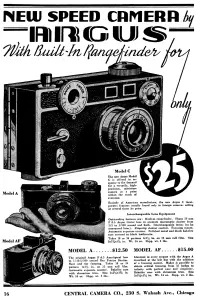
Under new management led by businessman Robert D. Howse, Argus reinstated radio production and quickly turned to military contracts for the US war effort in Europe. In the early 1940s, Argus became profitable again producing binoculars, gun sights, radio power supplies, remote controls, and other products for the United States and it’s allies. They also increased capacity for the Argus C3 35mm rangefinder and started producing a medium format twin lens reflex camera called the Argoflex.

By 1942, business was very good for Argus, with profits up to $4.8 million from a net loss in 1938. After the war, Argus sought to remain dominant in it’s consumer camera divisions but planned to continue it’s work with American and foreign militaries, using it’s experience to continue to develop optical and radio products. This was rather unique in the optics industry as most companies who turned to military production during the war, ceased all government contracts afterwards, but not Argus.
After the war, there was a disruption in supply of cameras and other optical equipment from Germany and many American companies took up the challenge to build all new models to compete for the American photographer’s buying dollar. Established companies like Kodak and ANSCO released new cameras in the late 1940s, as did some newcomers like Clarus and Vokar.
Argus was in the unique position as being the only one of those companies with a current best seller on their hands. The Argus C3, although approaching 10 years old was still very popular and was selling quite well. Unwilling to sacrifice the company’s most popular model, instead, they released an all new scale focus camera called the Argus Model 21, with an entirely new body and what they called a “Markfinder” viewfinder that had projected frame lines and a set of cross hairs in the center to aid in composition.
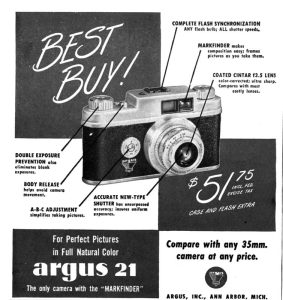
The Model 21 had an attractive new metal body with soft, rounded corners, a more standard left to right film transport, and a coupled wind knob that both advanced the film and cocked the shutter after each exposure. The Model 21’s lens could also be unscrewed and mounted to one of Argus’s available projectors at the time, allowing it to be used both in photographing and displaying slides, which were increasingly popular at the time.
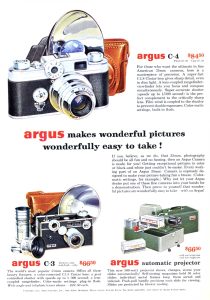
Although offering an appealing new design and some modern features, the Model 21 lacked a rangefinder or true interchangeable lenses, and didn’t sell well. Adding to this some internal difficulties at Argus and an all new management, led by Robert E. Lewis aimed to return the company to profitability. In the early 1950s, several new Twin Lens Reflex cameras, and an upgraded Model 21 called the Argus C4 made it’s debut.
The C4’s biggest upgrade was a coincident image coupled rangefinder and an upgraded, non removable 50mm f/2.8 Cintagon lens. The two cameras shared the same body and most of it’s parts. The C4 was a viable alternative to the C3 with better ergonomics, a larger and brighter viewfinder, coincident image rangefinder, and easier film loading. While not a smashing success, with a retail price of $84.50, it was only $18 more than the C3, and offered quite a number of improvements.
Although the C4 came standard with a fixed lens, Argus offered a modification to the camera which upgraded the lens to have a unique interchangeable bayonet lens mount which allowed the camera to use a series of four lenses imported from West Germany by a Chicago company called Geiss. This modification only cost $10 and dramatically improved the capabilities of the camera. The German lenses were built by Enna Werke and were of good optical quality.
In October 1954, Modern Photography published a four page review of the modified Argus C4 with Geiss lenses, showing what it was capable of. This modification was only done for about two years and as a result, modified C4s are hard to find today. The easiest way to spot them is that each modified camera has a bayonet release arm near the 3 o’clock position around the shutter. If you spot a C4 with this lever, you know its a modified one.
The Argus C4 remained in production for 8 years but in 1956 a revised model called the C44 would be released that added an interchangeable lens mount, finally returning the feature that had been present in the C3 since its release in 1938. The C44 would have an all new bayonet lens mount unique to that camera, and upon it’s release, would have three lenses available.
- 50mm f/2.8 Cintagon (standard lens)
- 35mm f/4.5 Cintagon – $56.50
- 100mm f/3.5 Cintagon – $59.50

Shortly after it’s release, a 50mm f/1.9 Cintagon would debut making it the fastest lens to ever appear on an Argus camera. This lens could be purchased with the C44 body for $149.50 or by itself for $89.50 which when adjusted for inflation is comparable to $1440 and $850 today.
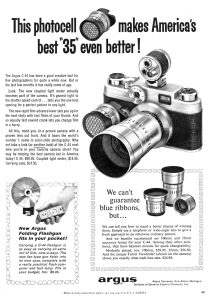
The C44 was only produced for two years before it was revised once again, this time adding a rapid wind lever and flip out rewind knob in place of the knobs, and revising the shutter speed knob to couple with the Argus CM2 exposure meter co-developed for use with this camera and the Argus C33. The new model was called the C44R with the “R” standing for “rapid”. The C44R was produced until late 1962 at which time the whole series was discontinued.
The whole Argus Model 21/C4/C44/C44R series was quite successful, being produced from 1948 – 1962 making it the second longest line of cameras made by Argus.
Although nowhere near built to the quality standards of German and Japanese rangefinders of the era, it offered most of the same features at prices significantly cheaper than imported cameras did. The build quality wasn’t quite as good, the camera was a bit stiff, the C44R lens mount was poorly designed, but the lenses were good and the camera produced good images.
As a follow up to their earlier review of the C4, in June 1956, Modern Photography posted a short special report on the C44, talking about it’s new lens mount and lens offering.
Today, the Argus C44R and it’s kin are rarely sought after by collectors. By the second half of the 20th century, most American cameras typically developed reputations as being cheap and poorly made alternatives to competing German and Japanese cameras. Kodak cornered the “family snapshooter” market with their various Instamatic and other basic cameras, and the pros generally went with the imports. This left very little room for companies like Argus to succeed, and although they would eventually dwindle away into bankruptcy, they made a pretty valiant effort with this series that is at least worth a look.
My Thoughts
The Argus C3 gets a bad rap from collectors who make fun of it’s brick like shape, its terrible ergonomics and poor interchangeable lens mount. Those people rarely mention that the C3 is actually a pretty capable camera and with a bit of patience is capable of some really terrific images. Considering the camera was originally built to have a target price of $25, the fact that it can do as many things as it can, is quite a testament to it’s design.
But what if the C3 had all the same features, but in a modern, more attractive body, with significantly better ergonomics, a combined coincident image viewfinder and rangefinder, and a rapid film advance lever? Wouldn’t a camera like that be pretty great? Read on…
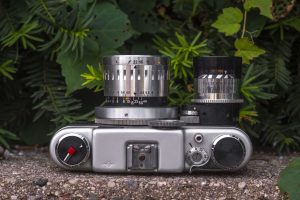
The top plate of the Argus C44R resembles most 1950s rangefinders with a red-tipped pop up rewind crank on the left, flash hot shoe in the center, a manually resetting exposure counter, shutter release with threaded cable socket, and rapid film advance lever. Looking down at the lens, you can see the aperture selector ring, and wide focus ring.
Where the top view of the camera is quite a bit different is in the optional auxiliary Argus CM2 exposure meter clipped onto the front, which I’ll get to later.
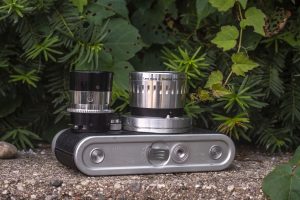
The bottom of the camera reveals the lock that when twisted releases the removable back and bottom to the camera, along with two small feet and the 1/4″ tripod socket. The tripod socket is part of the base of the camera, and not integral to the main camera body, which means it loses some strength if it were to be mounted to a tripod for extended periods of time.
As for the completely removable back, although this was still a common practice for cameras back then, its somewhat of a step back from the hinged door on the Argus C3. Although removable backs allow easier film loading on either side of the camera, having to keep track of a door is more effort than having a hinged door.
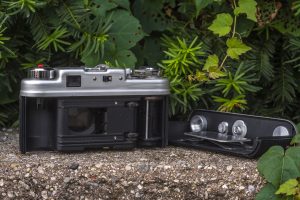
With the back off, we see a rather ordinary film compartment. Unlike the C3, the C4’s film travels from left to right onto a fixed take up spool. The spool has a unique method for attaching the leader with a metal bar that is pressed up against the plastic spool. Simply push the film leader under the metal bar and it’s tension against the spool keeps it in place. It’s not elegant, but it works! Notice the textured pattern on the metal film pressure plate. This kind of pattern was thought to provide less resistance to the film traveling across the film plane, making it easier to advance.
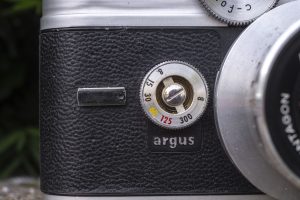
Up front is the shutter speed selector. This location is a direct result of the optional coupled Argus CM2 light meter that was available for this camera and could also be used on the Argus C33. Without it, you have a simple ring with speeds from 15 to 300 plus Bulb. Normally there would be a black plastic disc that covers the screw in the center, but with the meter, you need to clip it onto that horizontal metal bar on the left and then two forks inside of the meter engage on that center hub, coupling the meter to the shutter speed selector.

With the meter, you can no longer read the shutter speeds on the face of the dial, so instead Argus designed a metal ring that duplicates these numbers, facing upward, so that you can read them with the camera at waist level.
The clip on meter uses a selenium cell, so no batteries are necessary. To use it, you set your chosen film speed with a small selector on the bottom of the meter that you can see in the image earlier in this article where I show the bottom of the camera. With the film speed and shutter speed set, the meter will point to an appropriate f/stop that you must manually set yourself on the lens. It looks rather clunky in appearance, but works quite well. This type of clip on metering system was widely used by many manufacturers from Leitz to Canon.
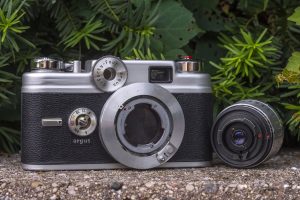
So far, most of the features I’ve shown you are improvements from similar features on the C4, but now we get to the interchangeable lens mount. I’ll start off by saying that yes, the C4’s proprietary lens mount is technically better than the C3s. It does not require removing of a coupling gear with the camera set to minimum focus taking care not to bump anything while changing lenses, but what follows isn’t much better.
The C44’s owners manual accurately describes the process for changing lenses as, “The ease with which the Argus C44 lenses are interchanged will amaze you.” They’re right. The process is amazing. Amazingly bad. Amazing in that literally every other interchangeable lens camera does it better. Amazing in that this was the best they could come up. Amazing in that Canon’s breech lock lens mount seems like a fantasy compared to this. Amazing in that the lens mount used on earlier Argus C4s with the Geiss lens modification were easier to take on and off. On his page dedicated to the Argus C44, Stephen Gandy doesn’t hold back, declaring the C44’s mount to be the worst he’s ever encountered, suggesting that aliens designed this mount to test the patience of humans, and that if your worst enemy wanted to learn photography, giving him or her an Argus C44 with a set of lenses would be good revenge.
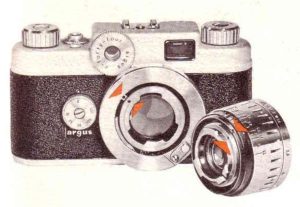
OKay, so maybe it’s not quite THAT bad. The Argus C44 uses a bayonet mount, and with every other bayonet lens mount, there’s usually a dot of some kind on the inside of the lens mount and a similar dot on the lens. Line up the two, push the lens on, give it a twist, and you’re done.
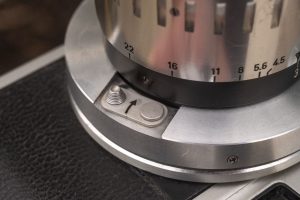
With the C44, there’s four dots, two each on the body and lens. The big issue is that the rings that have these dots, both independently move separate from each other, and without all four dots perfectly lined up, the lens will not attach to the body. Getting the lens off, requires it to be set at infinity and pressing on a release catch on the lens mount. This release catch is on a part of the lens mount that rotates as the camera is focused, so it’s position changes depending on what focus distance the lens is set to. Once the lens is off, extra care must be taken to not move anything on the lens or the camera, or else the dots won’t line up again.
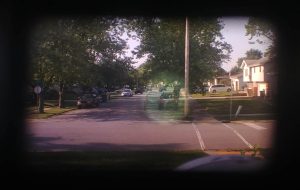
The viewfinder is a pretty standard combined coincident image type in which a circular rangefinder patch is superimposed over the middle of a larger image. The primary view has a slight purple tint to it which improves contrast on the rangefinder patch, making it easier to use.
The view through the viewfinder is fixed at 50mm and does not offer any sort of changeable frame lines for the wide or telephoto lenses that were available for the C44. To use those lenses, you must use some type of clip on accessory viewfinder, such as the Argus Variable Power Viewfinder or Argus Turret Viewfinders which have frame lines for 35mm and 100mm.
Overall, the C44R has nearly every feature that a modern semi-professional 35mm camera should have. It had an interchangeable lens mount, lever rewind and film advance, an optional coupled exposure meter, a coincident image coupled rangefinder, a self cocking shutter, and a modern body with most controls in logical places. Of course, just because something looks good on paper, doesn’t always translate into an enjoyable shooting experience. Was that the case with the Argus C44R/?
My Results
I took the Argus C44R out with me during a particularly cold spring this year loaded with some fresh Fuji 200. I am always eager in the spring time to get out and shoot color film after a cold winter in which I mostly shoot black and white, but the frequency of overcast skies sometimes negates any benefit I get from the color film.
In my time shooting all the cameras I’ve written about on this site, there are many examples where my experience with a particular model is more than the sum of it’s parts (or features). I’ve often been more impressed by a particular model after seeing the images I got from it than I was when I first got it. Sometimes you just need to experience a camera to truly understand it.
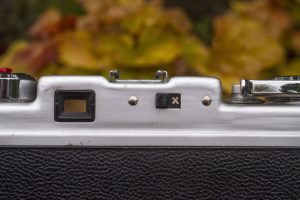
The Argus C44R is not one of those camera. I’ll start off by saying that I liked most of the choices that Argus made when designing this camera. There were a few oddities, such as the M/X flash sync switch, which looks like a power switch from a children’s toy. Ergonomically, this camera is leaps and bounds better than the C3. The inclusion of the rapid wind and fold out rewind lever are welcome additions that frankly, should have been there from the start. The coincident image rangefinder is very well made, easy to use, and larger than those found on many other mid century rangefinder cameras.
But, sadly, that’s where my praise for this camera ends. I really did not care for shooting it. If I had to whittle down this entire review to a single word, it would be “stiff”. Everything about this camera is stiff. Each motion of the film advance lever felt like something was perpetually going to break inside the camera. Changing focus was stiff, even the shutter release was stiff. Now, its entirely possible these symptoms are just of my particular model, but I don’t think so. I found similar stiffness in the Argus C33 I previously reviewed on the site, and in an Argus C4 that I have in my collection that I’m not going to review. I have a sneaking suspicion that while Argus had some good ideas, they lacked the precision mechanical experience to make a smooth camera.
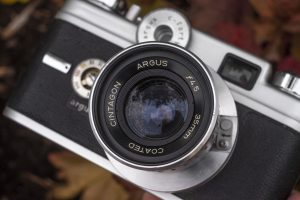
The exposure meter works quite well, but damn, is it ugly. To be fair, most clip on meters of the day looked bulbous and out of place, but Argus turned the silliness up to 11. I guess if I had to say one kind thing about it is, with the meter mounted, you can see your selected shutter speed from the top of the camera, but that’s about it.
I am not in love with the images I got from the Steinheil made wide angle Cintagon, and found them to be surprisingly soft. I did not have access to the 50mm f/2.8 Cintagon and while I normally favor wide angles over 50mm primes, I wonder if my thoughts would have changed with a different lens, but I expected more from German made optics like these.
The struggle with reviewing old cameras is that I often have to make judgement calls on a single example of a camera in which hundreds of thousands or even millions were produced. In addition, the age of these cameras also has an impact on their performance and while the performance of this particular 61 year old Argus C44R was less than memorable, that doesn’t mean others couldn’t have been. Argus did a lot of things right with this camera. It doesn’t have the precision build quality of a Leica or Nikon, but at a third the price, it doesn’t have to.
For those who think the C3 was Argus’s only successful camera series, I strongly urge you to check out a C44 or C44R. I think this camera has potential, and while they’re not perfect, they’re pretty decent cameras.
Related Posts You Might Enjoy
External Links
http://camera-wiki.org/wiki/Argus_C44R
https://www.cameraquest.com/argc44.htm

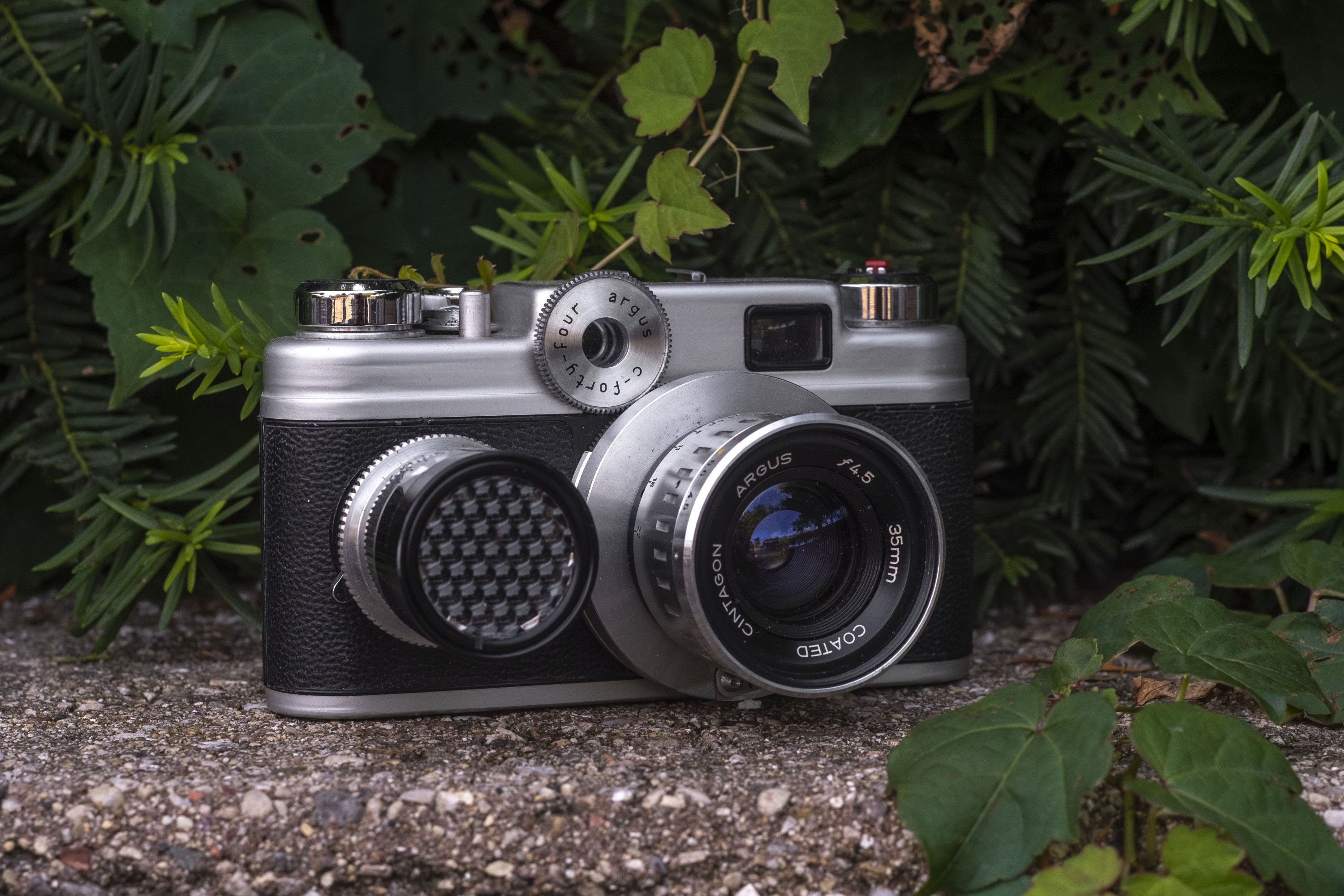
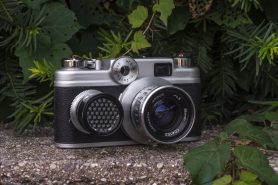
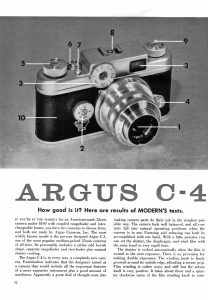
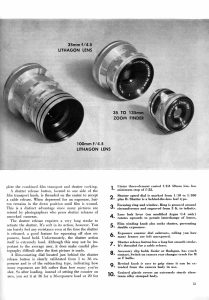
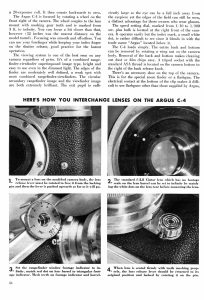
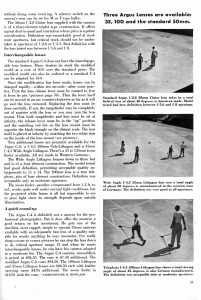
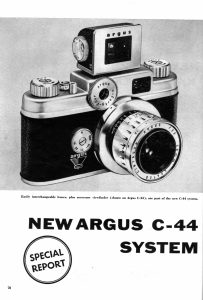
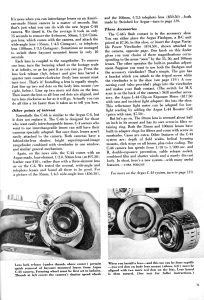













While the C3 lens is a screw mount, this originally was for ease of assembly rather than intended for interchangeable lenses. The first versions of the C3 lacked an auxiliary shoe so it was impossible to mount a view finder for other than the 50mm lens. Also interchangeable lenses did not become available until the 1950’s. Even then, changing lenses was a nightmare.
For some reason almost two years after the C4 was replaced by the C44, Argus produced about 6,000 C4R’s some of which were changed to accept Geiss lenses. In my not so humble opinion the C4R with the Geiss conversion is the best camera Argus every produced. I have found that the Geiss lenses are superior to the ones sold directly by Argus for the C44.
Finally, unless given a CLA almost all of the old Argus cameras are stiff. Fortunately there are a number of sites showing how this can be done.
I have heard quite a bit of praise for the Geiss modified C4 and would like to one day get a chance to shoot one!
Regarding your comments on the interchangeability of lenses on the C3 however, I don’t quite agree with you. While I do know that the auxiliary lenses were not immediately available upon the release of the C/C2/C3, the lens mount was definitely intended for interchangeable lenses from the very beginning. The ad earlier in this article from the 1938 Central Camera catalog for the original Argus C, specifically refers to it as “Interchangeable Lens Equipment” with lenses to be announced later. As to when they became available, I am uncertain.
And as for auxiliary viewfinders, Argus had a number of clip on viewfinders that worked without an accessory shoe. I have one in my collection and it wraps around the rear eye piece and has a hook that clips to the top of the main viewfinder window.
Mike, thanks for another interesting insight into American camera design of the post-WWII years. I’m getting the impression from your recent posts that the US makers sort of knew what they wanted in a camera, but somehow left it to aliens to design.
Off topic, slightly, is when I read your extract of Stephen Gandy’s quote. This had an immediate resonance with me as yesterday I was playing with my Rollei A26 which I’d not played with since I acquired it nigh on 3 years ago. Usually, I do not store my cameras with batteries in them for obvious reasons, so I was surprised when the green “Go” LED lit up. Immediately I thought I’d better get the battery out, praying it hadn’t leaked. This is when I hit a problem. Where’s the battery compartment? Nothing externally visible. Sliding the outer body off, there was no visible internal battery compartment cover either. I was expecting something similar to my Rollei 35, but no. Nowt. I was completely befuddled, how the heck does one change the battery? And where is it?
Googling, it turns out that the outer chrome ring that seems to be screwing in the PC socket actually isn’t. It’s notched for a coin and simply unscrewing it allows the entire left side of the camera to be removed to reveal the battery. Fortunately, it hadn’t corroded.
LOL! You might be onto something with American cameras left up to aliens to design! In the case of Kodak, it’s clear that the top brass at the company maintained a film first mentality. With only the rare exception, every Kodak camera was sold with the intent of getting more people to buy film, which explains the seemingly random directions they often went in with their cameras. For everyone else though, yeah, there’s definitely a chance Area 51 was involved. Some companies hit a homerun with their design, others, not so much!
Doh on the battery of the A26. That’s not a camera I’ve ever encountered. The strangest location for a battery compartment I’ve seen is on the Nikkormat EL and Nikon EL2 which have it located in a chamber behind the reflex mirror. You need to flip up the mirror, then release a very tiny latch on a door in the mirror box to get to the battery.
Mike, same with the Zeiss Contarex Super. Fortunately, I got the the manual with mine, otherwise I’d have been flummoxed.
Great article, Mike!
I thought I’d mention two Achilles’ heels of the C44R that I don’t think you touched on in your article:
– The first is shared with the C4 and 21 Markfinder – a tiny hardened steel link between the shutter blades and a shutter drive mechanism that has the power of a diesel truck: if the blades get sticky, there is enough power to break this link and kill the camera, so no camera in this series should be operated if the blades appear sticky or sluggish.
– the second is unique to the R series – the rewind release function puts a sideways load on the top of a tall pot metal post that’s attached to a steel gear plate. The leverage is enough to pry the post out of the plate, the pot metal can’t be soldered and epoxy isn’t strong enough to hold it in. I have a couple of rough-cast bronze replacement posts that were made by a C44R owner in Chicago …. he brazed one of these onto the plate and had me put the camera back together for him. His may be the only long term reliable C44R on the planet.
Very interesting Richard. This likely explains the stiffness that I encountered on mine. The weak points probably didn’t age well and could be on the verge of breaking on mine! Thankfully, I was able to get through my test roll! If I ever shoot this camera again and have issues, I’ll be sure to update my review.
Mike, I had a Geiss-mod C4 about ten years ago, and enjoyed shooting it. The lens mount design was odd, but not incomprehensible, involving careful pre-alignment of lens and focus mount – not unlike the C3. Mine has the 35mm f4.5 Lithagon but not the Argus variable viewfinder, so I mounted one from a Kodak Retina IIc. The Lithagon offered good resolution and fine color saturation, on a par with the gem-like 30mm Lydith f3.5. Your comments about the camera being “clunky and stiff” echo my sentiments about the Geiss-mod C4: Not really a keeper, more of a historical curiosity. Thank you for another excellent review!
Great article, Mike. I’ve been a C44 fan for several years. And oh, yes, to know and love this home-grown beast is to embrace its shortcomings and work around them. For the record, the stock normal-focal length 50mm lens provided on the C44 and C44R was not the f/2.8 Cintar—i.e. the Cooke-type triplet lens provided on the C4 (and subsequent short-lived C4R)—but rather the newly formulated 50mm Tessar-inspired 4-element f/2.8 Cintagon, developed and manufactured right there in Ann Arbor with computerized assistance from the University of Michigan’s MIDAC (Michigan Digital Automatic Computer) “magic brain”, which was quite impressive for 1956. The faster 50mm f/1.9 Cintagon that was introduced not long afterwards is a 6-element lens produced by Steinheil of Munich, the same company that manufactured the 35mm f/4.5 wide-angle and 100mm f/3.5 telephoto Cintagons. I don’t know how many elements are in the designs of the 35mm and 100mm Cintagons…wish I knew. Steinheil produced 6-element f/1.9 normal-focal length lenses for other camera manufacturers as well, e.g. their 55mm f/1.9 Auto-Quinon for Exakta (6 elements in 4 groups), and I’ve often wondered if Steinheil was using a similar design to produce their 50mm Cintagon for Argus.
I acquired a Steinheil-made 50mm f/1.9 Cintagon a few years ago—just one; they’re hard to come by and never cheap—which, thank God, came with its original lens hood/Series VI filter retainer. Having fiddled with more than one C44 over the years, I’ve acquired several Michigan-made stock 50mm f/2.8 Cintagons, from which I’ve naturally culled the best one or two specimens that are still clean and sharp enough to use. I honestly see little to no difference between photos taken with both my f/1.9 and best-condition f/2.8 Cintagons. The main reason I prefer to use the f/1.9 as the main 50mm lens on my C44 is that ALL Steinheil-made Cintagons—normal, wide-angle and telephoto—came with convenient lens hoods that serve as retaining rings for Series VI filters, which means I only have to carry one set of filters with me, regardless of the focal length of the lens I’m using. The 50mm f/2.8 Cintagon has a Series V filter retaining ring, which one can easily replace with a generic Series V lens hood, but it means lugging around another set of filters if I’m traveling with more than one lens.
As for the coatings on these Cintagons, whether Michigan- or Munich-made, it’s been my experience that, well, like so many other things, they don’t always age so well. I just take it in stride, and again, I cull the best-condition one or two examples, for each focal length, from all the others. I’m just a few years younger myself than the C44 that I’m currently using, and the way I see it, the faint spots here and there on my best Cintagons are no more prominent than the spots now appearing on my own hands and forearms. As long as they work, I’ll use them…lenses and limbs.
Thanks for the detailed response, Dixon! I have corrected my mistake saying the standard lens was the Cintar. I have updated the article with the correct name. Mine has some spots on it as well, which doesn’t seem to be affecting the images too bad. I also agree with you in that as cameras age and show signs of their age, that just makes them more interesting to me! I like those ‘battle scars’! 🙂
Finally, I will have a review of both the C4 Geiss and Argus SLR coming up later this year, so if you are an Argus fan, I have two more coming for you!
Mike, thank you for another fun and comprehensive article on one of my favorite rangefinders. I love my 44R with Cintagon 50mm f/1.9 and CM2 meter. To me the unusual appearance is a feature, not a flaw, perhaps related to growing up with Flash Gordon serials on television. No one is likely to mistake a C-44 for a modern camera and its looks are a great conversation starter.
The metallic crash of the shutter doesn’t offend me either. If I used the other lenses the clumsy mount might be a deal breaker but I stick with the 50mm. I don’t like auxiliary finders, not even the clever Argus Variable Power Finder.
Quality lens, excellent viewfinder, streamline-moderne styling, what more do I need?